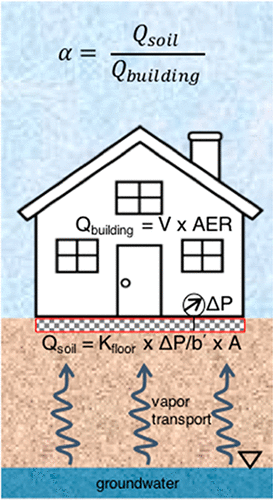当前位置:
X-MOL 学术
›
Environ. Sci. Technol.
›
论文详情
Our official English website, www.x-mol.net, welcomes your
feedback! (Note: you will need to create a separate account there.)
Fluid Flow Model for Predicting the Intrusion Rate of Subsurface Contaminant Vapors into Buildings
Environmental Science & Technology ( IF 10.8 ) Pub Date : 2018-07-13 , DOI: 10.1021/acs.est.8b01106 Todd A. McAlary 1 , John Gallinatti 2 , Gordon Thrupp 2 , William Wertz 3 , Darius Mali 4 , Helen Dawson 5
Environmental Science & Technology ( IF 10.8 ) Pub Date : 2018-07-13 , DOI: 10.1021/acs.est.8b01106 Todd A. McAlary 1 , John Gallinatti 2 , Gordon Thrupp 2 , William Wertz 3 , Darius Mali 4 , Helen Dawson 5
Affiliation

|
A new method is presented for calculating a building-specific subslab to indoor air attenuation factor for use in assessing subsurface vapor intrusion to indoor air. The technique includes (1) subslab gas extraction with flow and vacuum measurements and mathematical modeling to characterize the bulk average vertical gas conductivity of the floor slab, (2) monitoring of the ambient pressure gradient across the floor slab with a micromanometer, (3) calculating the volumetric flow of soil gas into the building (Qsoil), and (4) dividing Qsoil by the building ventilation rate (Qbuilding) to calculate a building-specific attenuation factor. Sample calculations using order statistics from 121 individual tests are comparable to the U.S. Environmental Protection Agency empirical attenuation factors for residential buildings and the U.S. Navy empirical attenuation factors for commercial/industrial buildings. A case study of a commercial building shows encouraging agreement between the attenuation factors calculated via this method and via conventional subslab and indoor air sampling.
中文翻译:

预测地下污染物蒸气进入建筑物的速率的流体模型
提出了一种计算建筑物特定的子板对室内空气衰减因子的新方法,以用于评估地下蒸汽对室内空气的侵入。该技术包括(1)利用流量和真空测量以及通过数学建模来表征楼板的总体平均垂直气体电导率的子楼板气体提取;(2)用微压计监测整个楼板的环境压力梯度;(3)计算进入建筑物的土壤气体的体积流量(Q土),以及(4)将Q土除以建筑物的通风率(Q建筑物)),以计算特定于建筑物的衰减因子。使用来自121个单独测试的订单统计数据进行的样本计算可与美国环境保护局针对住宅建筑的经验衰减因子和美国海军针对商业/工业建筑的经验衰减因子相媲美。某商业建筑的案例研究表明,通过这种方法以及通过常规子面板和室内空气采样计算得出的衰减因子之间令人鼓舞的一致性。
更新日期:2018-07-14
中文翻译:

预测地下污染物蒸气进入建筑物的速率的流体模型
提出了一种计算建筑物特定的子板对室内空气衰减因子的新方法,以用于评估地下蒸汽对室内空气的侵入。该技术包括(1)利用流量和真空测量以及通过数学建模来表征楼板的总体平均垂直气体电导率的子楼板气体提取;(2)用微压计监测整个楼板的环境压力梯度;(3)计算进入建筑物的土壤气体的体积流量(Q土),以及(4)将Q土除以建筑物的通风率(Q建筑物)),以计算特定于建筑物的衰减因子。使用来自121个单独测试的订单统计数据进行的样本计算可与美国环境保护局针对住宅建筑的经验衰减因子和美国海军针对商业/工业建筑的经验衰减因子相媲美。某商业建筑的案例研究表明,通过这种方法以及通过常规子面板和室内空气采样计算得出的衰减因子之间令人鼓舞的一致性。











































 京公网安备 11010802027423号
京公网安备 11010802027423号